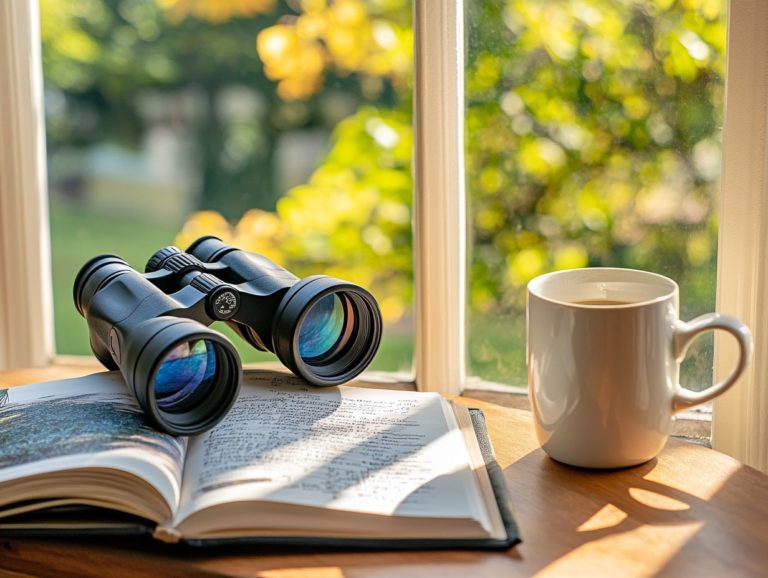How Can I Prepare for Different Bird Watching Seasons?
Birding is an exhilarating hobby that evolves with the changing seasons. Each season offers unique opportunities to observe specific bird species, explore different locations, and utilize various equipment tailored for distinct experiences.
This guide outlines the essential gear required for each season while highlighting the best locations and species to observe. It also provides tips for overcoming seasonal challenges in birdwatching, regardless of the climate.
Contents
- Key Takeaways:
- Spring: The First Signs of Life for Birds
- Summer: The Joys of Nesting and Raising Young
- Fall: The Spectacle of Migration
- Winter: The Beauty of Adaptation and Resilience
- Essential Gear for Bird Watching
- Spring Bird Watching
- Summer Bird Watching
- Fall Bird Watching
- Winter Bird Watching
- Frequently Asked Questions
- What are the different birdwatching seasons and when do they occur?
- How can I prepare for spring birdwatching season?
- What should I consider when preparing for summer birdwatching season?
- What steps can I take to prepare for fall birdwatching season?
- How can I get ready for winter birdwatching season?
- What are some general tips for preparing for any birdwatching season?
Key Takeaways:
- Understand the different bird species and their behaviors during each season.
- Invest in essential gear to enhance your birdwatching experience, including binoculars and field guides.
- Research and plan ahead for the best locations and species to look for, such as spring migration or winter bird feeding areas.
Understanding the Different Seasons
The changing seasons play a crucial role in birdwatching, presenting unique opportunities and challenges. Each season—spring, summer, fall, and winter—offers distinct types of bird life influenced by migration patterns and behaviors.
Spring marks the migration period. Summer is dedicated to nesting. Fall sees another wave of migration, while winter is characterized by both common and winter-adapted bird species. Engaging with these seasonal changes allows birdwatchers to appreciate the balance of nature.
Spring: The First Signs of Life for Birds
Experience the thrill of birdwatching this spring as nature awakens from its winter dormancy. Migratory birds return from their winter habitats, filling the air with cheerful chirping.
Species such as warblers, finches, and orioles typically appear from mid-March to early May, depending on the region. Birdwatchers can spot these species in a variety of settings, including backyards, parks, and nature reserves.
This season is ideal for honing birdwatching skills, as many species are easily observable and identifiable. Males display their vibrant plumage to attract females, making them more conspicuous. The presence of many migratory birds creates a lively and colorful environment.
Join the excitement of birdwatching by participating in citizen science projects like the Great Backyard Bird Count, contributing to the tracking and monitoring of bird populations. As migratory birds return, their increased singing makes it easier for enthusiasts to locate them.
Summer: The Joys of Nesting and Raising Young
Summer offers captivating birdwatching opportunities as many species focus on nesting and raising their young. Observing behaviors such as feeding and caring for chicks provides valuable insights into their reproductive cycles.
This season is perfect for sharpening bird identification skills, as many birds become more visible and vocal. Birdwatchers often see birds gathering food to bring back to their nests.
Setting up feeding stations can assist local birds and create additional opportunities for observation. Summer is also prime for participating in citizen science projects like the Nest Watch program, which involves monitoring local species.
Fall: The Spectacle of Migration
Fall is a spectacular time for birdwatching, as many species embark on their migratory journeys southward. Witness breathtaking flocks of sparrows, geese, and other species flying to warmer climates.
This season offers an excellent opportunity to observe migratory behaviors, including feeding and resting patterns. Birdwatchers can set up feeding stations or water sources to support local birds.
As many species fatten up for their long journeys, birdwatchers can observe their feeding habits closely. Participate in citizen science projects like the Fall Migration Count to track and document migrating birds in your area.
Embrace the joy of birdwatching in every season!
Winter: The Beauty of Adaptation and Resilience
Winter is a beautiful season for bird watching, as many species adapt to and thrive in colder conditions. Bird watchers can observe behaviors such as flocking and foraging, providing insights into how different species cope with harsh weather. This time of year is ideal for honing identification skills, as many birds become more visible and audible. Species like cardinals, blue jays, and chickadees frequently visit backyard feeders, offering plentiful opportunities for observation.
Winter allows bird watchers to join citizen science projects like the Christmas Bird Count. This project involves tracking and documenting bird populations in specific areas. Joining local birding clubs can enhance the experience, providing organized outings and events for observing and counting local bird populations.
Essential Gear for Bird Watching
Essential tools for birdwatching enhance your overall experience. The most important items include:
- High-quality binoculars for observing birds from a distance.
- Field guides for identifying various species. Field guides are books that help identify different bird species.
- Digital tools such as the Merlin app, which assists users in identifying birds by sound and image.
Recommended Equipment for Each Season
Choosing the right bird-watching equipment based on the season is essential for effectively spotting and identifying birds. Each season presents distinct behaviors and environmental factors that influence these choices.
- Spring:
- Binoculars: Lightweight and easy-to-carry binoculars are ideal for spring. Multi-coated lenses enhance focus and clarity while reducing disruptive external light.
- Lenses: Versatile and lightweight lenses are helpful as migratory birds return to their nesting grounds.
- Field Guide: Compact field guides, such as Peterson’s Field Guides for North American Birds, are perfect for portability.
- Carry Bags: Light backpacks with reflectors improve visibility in varying light conditions.
- Summer:
- Binoculars: Binoculars with multi-coated lenses that enhance clarity and capture minute details are essential in summer.
- Field Guide: Compact, portable field guides that include details on bird vocalizations are ideal, especially as young birds learn to sing.
- Carry Bags: Lightweight backpacks equipped with water bottles help keep bird watchers hydrated.
- Fall:
- Binoculars: Binoculars with fog-proof and waterproof features are best for fall, as temperatures may drop and humid air can condense on the lenses. Multi-coated lenses that enhance focus and clarity are important for observing larger migratory flocks.
- Field Guide: Lighter, mobile field guides that cover a range of migratory birds are necessary to track the sparser populations in fall.
- Carry Bags: Insulated backpacks are useful for carrying portable ovens to cook and warm bird feed.
- Winter:
- Binoculars: Specialized binoculars that are waterproof and fog-proof are ideal for winter. Insulated models can help reduce the chill from metal and plastic components. Lenses that facilitate long-range visibility and low-light detection are also important, as winter days are shorter.
- Field Guide: Durable, snow-proof field guides are essential, as they can be carried outside a jacket without damage.
- Carry Bags: Insulated backpacks are perfect for holding warmth while keeping small items secure.
In summary, choosing the right bird-watching gear for each season is not just practical; it makes each outing more enjoyable. Equip yourself accordingly to enhance your birdwatching adventures!
Spring Bird Watching
Spring birdwatching is thrilling as migratory birds return! This is the perfect time to identify various species and enjoy the vibrant, lush landscapes. During this season, many common bird species can be observed amidst lush green surroundings, making it an ideal time for birdwatchers to explore state parks and wildlife-rich areas.
Witnessing spring bird behaviors, such as mating and nesting, enhances the birdwatching experience.
Best Locations and Species to Look for
Spring is a great time to observe birds. You can spot many common species returning from their migration.
Wetlands, forests, and suburban backyards come alive with birdlife during this season. These locations often host birds like the American Goldfinch and Warbling Vireo, making it an ideal time for identifying different species.
Some excellent spots for birdwatching in spring include coastal wetlands along the Atlantic coast, where you might see Red-winged Blackbirds. Dense forests in the Pacific Northwest are also great, where the hard-to-find Pacific Wren can often be heard more than seen.
For effective bird identification, use field guides, which are books or apps that help you identify different bird species, and reliable birding apps. They provide essential information about markings, calls, and behaviors unique to each species. Keeping a journal of sightings can help you recognize patterns in bird appearances over the years.
While the best spots to see birds in spring may vary for each person, exercising patience is key. Engaging in quiet observation, planning early morning excursions, and using binoculars can significantly enhance your birdwatching experience.
Summer Bird Watching
Summer birdwatching offers enthusiasts a unique opportunity to observe how birds behave during their nesting and feeding seasons. This makes it one of the most rewarding times of the year for dedicated birdwatchers.
The heat can be a challenge, but early morning outings can enhance sightings during the warmer summer months. You are more likely to spot birds and their fledglings in their natural habitats during this season.
Backyard birdwatching is especially enjoyable in summer, as many species flock to feeders stocked with appropriate food.
Tips for Hot Weather Birding
Birdwatching in hot weather requires specific strategies for both comfort and success. Staying hydrated is crucial during summer outings, especially if you plan to spend extended time outdoors.
Wearing lightweight clothing and seeking shaded areas enhances your experience. Schedule your outings during the cooler parts of the day, like early morning or late afternoon, when birds are more active and less stressed by the heat.
Check the local weather forecast to find the best times for spotting specific species. Being quietly observant is beneficial, as many birds tend to hide from the sun during the day and blend into their surroundings.
Using UV-protected binoculars can improve visibility while minimizing eye strain in bright sunlight.
Fall Bird Watching
Fall birdwatching is an excellent opportunity to observe migration patterns. Many bird species travel south for the winter, creating a captivating spectacle for birdwatchers.
Understanding where to look can significantly enhance your fall birdwatching experience. Prime viewing spots often serve as stopover points for migratory birds, allowing you to see a variety of common species as they prepare for their journey.
Migration Patterns and Prime Viewing Spots
Migration patterns play a crucial role in fall bird watching. Many species travel thousands of miles during this season, and their movements are generally predictable.
This predictability allows observers to pinpoint prime viewing locations and appreciate the significance of wetlands, lakes, and forest edges for ecological balance.
Various species migrate in the fall based on factors like food availability, temperature changes, and daylight length. Shorebirds typically migrate earlier than songbirds, with many already headed south by late September.
Key birdwatching locations include the Atlantic Flyway, a major migratory route where the highest number and variety of species can be observed during peak migration periods.
Enhance your chances of spotting and identifying these migratory travelers by using binoculars and field guides. Plan your outings for early morning or late afternoon to catch the most activity.
Winter Bird Watching
Winter birdwatching presents unique challenges, yet it offers enthusiasts the opportunity to observe various species that thrive in cold environments. While the chilly weather may push many birdwatchers indoors, wearing warm clothing, setting up feeders, and searching for birds in sheltered areas can significantly enhance the winter birdwatching experience!
Challenges and Strategies for Cold Weather Birding
Cold weather birding presents its own set of challenges. Spotting birds in bare trees can be difficult, and harsh weather conditions affect bird behavior and patterns. Use heated shelters and dress in layers. Low-light binoculars are also helpful.
During winter, many birds alter their normal behaviors. They flock together for warmth and food, making it essential for you to know where to find them. You can boost your chances of spotting winter birds by familiarizing yourself with the species commonly seen in your area and the habitats they prefer.
Setting up feeders with the right food attracts more birds. Observing bird activity near water sources, which often serve as socializing spots for birds, can also aid in spotting them.
Patience is crucial during the winter months. Some birds may be less active in cold temperatures, necessitating strong observation skills and a comfortable setup to fully enjoy cold weather birding.
Frequently Asked Questions
What are the different birdwatching seasons and when do they occur?
The different birdwatching seasons are spring, summer, fall, and winter. Spring typically occurs from March to May, summer from June to August, fall from September to November, and winter from December to February.
How can I prepare for spring birdwatching season?
To prepare for spring birdwatching season, research which bird species migrate to your area during this time and familiarize yourself with their songs and behaviors. Check the weather forecast beforehand to ensure you’re prepared!
What should I consider when preparing for summer birdwatching season?
When preparing for summer birdwatching season, note the hot and humid weather. Plan for sun protection and hydration. Research which bird species are active during this time and their preferred habitats.
What steps can I take to prepare for fall birdwatching season?
To prepare for fall birdwatching season, research which bird species migrate through your area. Prepare for cooler weather and changing foliage. Bring along a field guide to help identify different birds and their behaviors.
How can I get ready for winter birdwatching season?
Before heading out to birdwatch in the winter, dress warmly and plan for snowy or icy conditions. Research which birds are commonly seen during this time and have a plan for staying safe in potentially hazardous outdoor conditions.
What are some general tips for preparing for any birdwatching season?
- Bring binoculars, a camera, and a notepad to take notes.
- Join local birdwatching groups or forums to learn about recent sightings and tips for specific areas.
- Always respect the birds and their habitats by following designated trails and keeping a safe distance.
Get out there and start your winter birdwatching adventure today!






